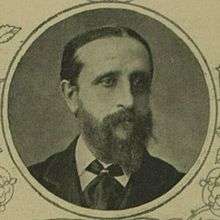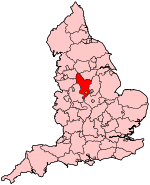High Peak is a constituency[n 1] represented in the House of Commons of the UK Parliament since 2017 by Ruth George, from the Labour Party.[n 2]
Boundaries
1885–1918: The Municipal Borough of Glossop, and the Sessional Divisions of Buxton, Chapel-en-le-Frith, and Glossop.
1918–1950: The Municipal Boroughs of Buxton and Glossop, the Urban District of New Mills, the Rural Districts of Glossop Dale and Hayfield, and parts of the Rural Districts of Bakewell and Chapel-en-le-Frith.
1950–1983: The Municipal Boroughs of Buxton and Glossop, the Urban Districts of New Mills and Whaley Bridge, and the Rural District of Chapel-en-le-Frith.
1983–2010: The Borough of High Peak, and the District of West Derbyshire wards of Bradwell, Hathersage and Tideswell.
2010–present: The Borough of High Peak.
The constituency covers much of northern Derbyshire and represents most of the west of the Peak District which encircles Buxton and Glossop.[2] Crowden, Tintwistle and Woodhead (formerly within the boundaries of Cheshire and in the Stalybridge and Hyde constituency) were brought into the seat in the boundary changes for the 1983 general election. The constituency boundaries became co-terminous with the local government district at the 2010 general election.
Constituency profile
Areas around the Hope Valley have a Conservative majority, whereas the north western part of the constituency, in Glossop (especially the Manchester overspill estate of Gamesley), Hadfield and Tintwistle, are more Labour-inclined. Buxton is often divided between the two main parties. The seat has considerable connections with Manchester (and the Hope Valley with Sheffield), rather than the East Midlands.
History
The seat was created in the Redistribution of Seats Act 1885. Since 1910 the seat has returned a Conservative MP apart from during three periods. A Labour Party representative was elected for the first time in 1966, but lost it at the next general election. Labour next won the seat at the 1997 landslide general election and held it at the other two general elections during the Blair ministry, but it was regained by the Conservatives at the 2010 election. It returned to Labour at the 2017 general election when Ruth George gained the seat, the first time Labour held High Peak without winning the general election overall in its history.
Members of Parliament
Elections

Historical election results for High Peak
Elections in the 2010s
Elections in the 2000s
Elections in the 1990s
Elections in the 1980s
Elections in the 1970s
Elections in the 1960s
Elections in the 1950s
Elections in the 1940s
Elections in the 1930s
At the High Peak by-election, 1939, Hugh Molson was elected unopposed.
Elections in the 1920s

Lady Barlow
Election results 1885–1918
Elections in the 1880s

Sidebottom
Elections in the 1890s

Cheetham
Elections in the 1900s

Partington
Elections in the 1910s
General Election 1914/15:
Another General Election was required to take place before the end of 1915. The political parties had been making preparations for an election to take place and by the July 1914, the following candidates had been selected;
- endorsed by Coalition Government
See also
Notes and references
- References
- Craig, F. W. S. (1983). British parliamentary election results 1918–1949 (3 ed.). Chichester: Parliamentary Research Services.
- Guardian Unlimited Politics (Election results from 1992 to the present)
- Politics Resources (Election results from 1931 to the present)
- ↑ "Electorate Figures – Boundary Commission for England". 2011 Electorate Figures. Boundary Commission for England. 4 March 2011. Archived from the original on 6 November 2010. Retrieved 13 March 2011.
- ↑ "Map of Peak District National Park". Retrieved 27 October 2015.
- ↑ Leigh Rayment's Historical List of MPs – Constituencies beginning with "H" (part 3)
- ↑ "Mr William Sidebottom, former MP, High Peak". TheyWorkForYou. Retrieved 27 October 2015.
- ↑ By-Elections in British Politics, 1832–1914. Boydell Press. 2013. p. 258.
- ↑ Cooper, Glynis (2015). Glossop in the Great War. Pen and Sword. p. 29.
- ↑ "The Announcement..." (PDF). The British Journal of Nursing. 085: 231. September 1937. Retrieved 27 October 2015.
- ↑ Hazlehurst, Cameron; Whitehead, Sally; Woodland, Christine (1996). A Guide to the Papers of British Cabinet Ministers 1900–1964. Cambridge University Press. p. 269.
- ↑ "Mr David Walder". Hansard. UK Parliament. Retrieved 27 October 2015.
- ↑ "Mr Peter Jackson". Hansard. UK Parliament. Retrieved 27 October 2015.
- ↑ Skinner, Dennis (2014). Sailing Close to the Wind: Reminiscences. Hachette UK. p. 85. ISBN 1784291234.
- ↑ "Mr Christopher Hawkins". Hansard. UK Parliament. Retrieved 27 October 2015.
- ↑ "Charles Hendry". politics.co.uk. Retrieved 27 October 2015.
- ↑ Carr, Sue (18 November 2009). "MP Tom Levitt to step down". Retrieved 27 October 2015.
- ↑ "Andrew Bingham MP, High Peak". TheyWorkForYou. Retrieved 27 October 2015.
- ↑ Hayes, Dan (3 May 2017). "GENERAL ELECTION: High Peak Labour pick local union campaigner". Buxton Advertiser. Retrieved 9 May 2017.
- ↑ Dodds, Jonathan (21 April 2017). "Conservative MP Andrew Bingham to defend High Peak seat in general election". Derbyshire Times. Retrieved 9 May 2017.
- ↑ Ball, Lucy (6 May 2017). "Liberal Democrats announce High Peak candidate for general election". Buxton Advertiser. Retrieved 9 May 2017.
- ↑ Higgins, Adam (9 June 2017). "High drama in High Peak as Labour take control". Glossop Chronicle. Retrieved 9 June 2017.
- ↑ "Election Data 2015". Electoral Calculus. Archived from the original on 17 October 2015. Retrieved 4 March 2017.
- ↑ "High Peak Parliamentary Constituency – Election 2015". BBC News.
- ↑ "Election Data 2010". Electoral Calculus. Archived from the original on 17 November 2015. Retrieved 4 March 2017.
- ↑ "High Peak Parliamentary Constituency – Election 2010". BBC News.
- ↑ "Election Data 2005". Electoral Calculus. Archived from the original on 15 October 2011. Retrieved 4 March 2017.
- ↑ "Election Data 2001". Electoral Calculus. Archived from the original on 15 October 2011. Retrieved 4 March 2017.
- ↑ "Election Data 1997". Electoral Calculus. Archived from the original on 15 October 2011. Retrieved 4 March 2017.
- ↑ "Election Data 1992". Electoral Calculus. Archived from the original on 15 October 2011. Retrieved 4 March 2017.
- ↑ "Politics Resources". Election 1992. Politics Resources. 9 April 1992. Retrieved 6 December 2010.
- ↑ "Election Data 1987". Electoral Calculus. Archived from the original on 15 October 2011. Retrieved 4 March 2017.
- ↑ "Election Data 1983". Electoral Calculus. Archived from the original on 15 October 2011. Retrieved 4 March 2017.
- ↑ "Politics Resources". Election 1979. Politics Resources. Retrieved 27 October 2015.
- ↑ "Politics Resources". Election October 1974. Politics Resources. Retrieved 27 October 2015.
- ↑ "Politics Resources". Election February 1974. Politics Resources. Retrieved 27 October 2015.
- ↑ "Politics Resources". Election 1970. Politics Resources. Retrieved 27 October 2015.
- ↑ "Politics Resources". Election 1966. Politics Resources. Retrieved 27 October 2015.
- ↑ "Politics Resources". Election 1964. Politics Resources. Retrieved 27 October 2015.
- ↑ 1961 by Election Results
- ↑ "Politics Resources". Election 1959. Politics Resources. Retrieved 27 October 2015.
- ↑ "Politics Resources". Election 1955. Politics Resources. Retrieved 27 October 2015.
- ↑ The Times' Guide to the House of Commons. 1955.
- ↑ "Politics Resources". Election 1951. Politics Resources. Retrieved 27 October 2015.
- ↑ "Politics Resources". Election 1950. Politics Resources. Retrieved 27 October 2015.
- ↑ "Politics Resources". Election 1945. Politics Resources. Retrieved 27 October 2015.
- ↑ "Politics Resources". Election 1935. Politics Resources. Retrieved 27 October 2015.
- 1 2 3 The Constitutional Year Book 1938, p.230
- 1 2 3 4 5 6 7 8 British Parliamentary Election Results 1885–1918, FWS Craig
- 1 2 3 4 5 6 The Liberal Year Book, 1907
- ↑ Debrett's House of Commons & Judicial Bench, 1886
- 1 2 Debrett's House of Commons & Judicial Bench, 1901
- ↑ Debrett's House of Commons & Judicial Bench, 1916
- ↑
- ↑ Derbyshire Courier, 4 Aug 1914
- Notes
|
|---|
| Major settlements | |
|---|
| Villages | |
|---|
| Waterways | |
|---|
| Transport | |
|---|
Culture, leisure
and tourism | |
|---|
| Related articles | |
|---|
Coordinates: 53°21′N 1°51′W / 53.35°N 1.85°W / 53.35; -1.85






